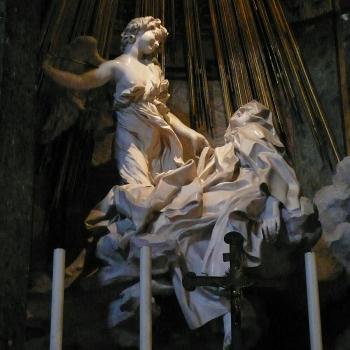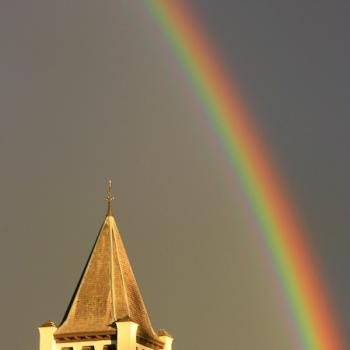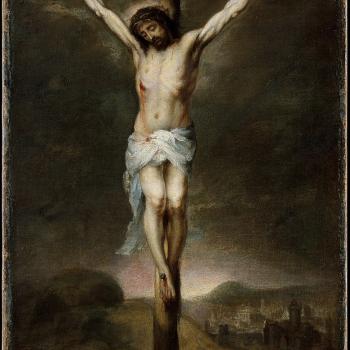One of the biggest gaps in the book is its relative silence about prayer. There’s a lot about horizontal relationships with other people–even when prayer is mentioned it’s often prayer to saints, which is still a horizontal relationship although maybe a tilted one–but not much about the vertical relationship of the human soul to God.
This is why e.g. I was so struck by St Gregory of Nyssa’s discussion of virginity: For him the vertical relationship is overwhelming, and horizontal relationships are often a distraction. Whereas I basically wrote my book to help gay Christians form horizontal relationships.
So here are some scattered notes on prayer, and especially prayer for gay Christians. There’s nowt so queer as prayer.
First, I do hide some discussion of prayer in the book. I talk a lot about honesty, and how hard it is, and how necessary it is. A huge amount of prayer is just being honest with yourself and then opening up that honesty to God. There’s nothing you think that is too awful for Him to hear. You change the nature of your thoughts and feelings simply by offering them to God: Whatever is going on with you, He already knows it, but He wants you to make the choice to tell Him because that will do you good.
Honesty with God is still something I struggle with, but it has made me much more trusting of Him and maybe less perfectionist and discouragement-prone. The times when I’ve had to pray, “God, I’m being creepy and fatalist. I feel like I’m definitely going to sin; in fact it feels like it’s already happened, what the literary critics call prolepsis (I don’t say this when I pray because not even Harold Bloom has much to teach the Lord), and I can’t honestly ask You to stop me. I hate feeling like this but apparently I also like it. All I can do right now is talk to You and tell You what’s going on, which You already know, this seems stupid. I am going to trust that there’s some point in saying all this,” while depressing in the moment, have gradually made me a lot less fatalist and a lot more reassured about God’s love for me.
I like what I said in the America interview about this stuff.
Second, if I’m recalling it correctly, Same-Sex Desire in Victorian Religious Culture argues that one reason so many same-sex attracted people were drawn to Catholicism and “High Church” Anglicanism in the Victorian era was because these churches helped them express same-sex eros through mystical prayer and poetry. “Eros” here doesn’t mean sexual desire. It’s something more primal. Sexual desire is one channel through which this powerful river can flow. Think of Bernini’s Teresa. It’s reductive to think that’s a statue “about” sex; it’s a statue about something which sex, too, is about.
Catholicism allows men to express intense longings for physical intimacy with Jesus. Thomas a Kempis’s beautiful “Reflections on the Passion of Christ” include a section which essentially rewrites the Song of Songs so that the speaker’s soul is the bride and Jesus crucified is the bridegroom. (Again you can see how this isn’t about sex. You’d have to be way more edgy-goth-teen than I’ve ever been to think that Jesus on the cross is sexy.) St John of the Cross’s “Dark Night of the Soul,” which I don’t at all understand so bear with me, uses impassioned language of seeking the beloved in the hushed dark.
And Catholicism allows women to express intense longings for physical intimacy with Mary, in some cases, or the Church as the Bride of Christ, in others. I don’t remember the examples Roden cites for Marian devotion among same-sex attracted women, but I caught my breath the first time I read this passage from Anglican poet Eliza Kearny:
Once, twice, thrice–as I crept close
Into the ark, the nest, the bride,
Into the pulse, into the life, into the wounded side
The sensual imagery switches sexes–we’re entering the Church as both Bride of Christ and wounded Body of Christ. Again this is erotic, not sexual; not even St Mary of Egypt tried to have sex with the Church. Kearny is expressing the arrow-sharp longing at the heart of Christian mysticism.
My own Marian devotion doesn’t strike me as particularly queer. I relate to Mary as a mother, in a fairly average Cat’lick somewhat sentimental way. You get a good sense of where I’m coming from on Marian devotion from my “musical rosary” series from this summer. I point this out partly because I’m endlessly interesting to myself, but also because I am not trying to say that every aspect of gay/queer/same-sex attracted Christians’ prayer life is or should be noticeably affected by our sexual orientation. That would be sexualizing gay people. Some aspects of my prayer life are queer–I’m about to get to that. But some aspects are really standard Ave-Ave-Ave-Mariiiiiiiiia-type stuff.
My devotion to the Church as the Bride of Christ really is pretty queer, I think. I long for Her in a way which feels somehow parallel to the way I used to relate to girlfriends. I want to serve Her and I feel a sometimes overprotective allegiance to Her. It’s not a child-parent relationship but very much a lover-beloved one. I need Her in an ongoing way, even beyond the way I need Mary. I can sense some kind of metaphorical reality in this image; the statues and smoke at church are Her clothes, and the worn faces at church are the contours of Her face. Both the obvious beauty and the brokenness are beautiful to me, because I love Her.
And finally, I wrote in an earlier Book Extra about my intuition or suggestion that same-sex attracted Christians may gain a lot from cultivating some kind of spirituality in which we delight in the opposite sex. The Anima Christi is one way I do that for myself. For men I think some form of devotion to Mary or to the Church-as-Bride might be fruitful.
Well, there, you can see that my thoughts are still half-formed at best. Let me know what you think!











